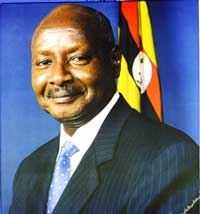 President of the Republic of Uganda H.E. Yoweri Kaguta MUSEVENI |
 H.E. Ambassador Ms. Mirjam Blaak-Sow |
Country Profile
|
Uganda is located in the heart of Sub-Saharan Africa and lies astride the Equator. The total area of the country is about 241,039 square kilometers of which about 43,942 sq. km are covered by fresh water bodies and swamps. Uganda is a country strategically positioned within East and Central Africa, a region that includes some of Africa's most economically important and resource rich countries with a substantial market and great future potential. The country is land-locked and borders the Sudan to the north, the Democratic Republic of Congo to the west, Kenya to the east, and Tanzania and Rwanda to the south.
Country Data
| ||||||||||||||||||||||||||||||||||||||||||||||||||||||||||||||||||||||||||||||||||||||||||||||
Standing on a green mound is a shield and two crossed spears. The green symbolizes Uganda's lush, green vegetation. Supporting the shield are the Uganda Kob (Adenota kob Thomasi), symbolizing abundance of wildlife; and the Crested Crane (Regulorum gibbericeps), Uganda's national bird. The shield and spears symbolize our readiness to defend our motherland against all enemies. Across the top of the shield are the waves of Lake Victoria, the second largest fresh water lake on earth. In the centre of the shield is the sun, representing Uganda's glorious sunny days. At the bottom of the shield is the traditional African drum, used for dancing, ceremonial rituals, and for summoning the people to rally. Coffee and cotton, Uganda's main cash crops, are displayed on the green mound; together with the River Nile, the world's longest river; which starts its 8000 km (5000 mile) journey in Uganda. The Uganda motto is "For God and My Country".
"Oh Uganda, Land of Beauty" is the Uganda National Anthem. It was adopted in 1962 with words and music composed by George Wilberforce Kakoma. Oh, Uganda! May God uphold thee, --------------------- Oh, Uganda! The land of freedom, ---------------------- Oh, Uganda! The land that feeds us, Public Holidays 2012Muslim festivals are timed according to local sightings of various phases of the moon and the dates given here are approximations. During the lunar month of Ramadan that precedes Eid al-Fitr, Muslims fast during the day and feast at night and normal business patterns may be interrupted. Many restaurants are closed during the day and there may be restrictions on smoking and drinking. Some disruption may continue into Eid al-Fitr itself. Eid al-Fitr and Eid al-Adha may last anything from two to 10 days, depending on the region. January 1 (Sunday) New Year's DayJanuary 26 (Thursday) Liberation Day March 8 (Thursday) International Women's Day April 6 (Friday) Good Friday April 9 (Monday) Easter Monday May 1 (Tuesday) Labour Day June 3 (Sunday) Martyrs' Day June 9 (Saturday) National Heroes' Day August 19 (Sunday) Eid al-Fitr (End of Ramadan) October 9 (Tuesday) Independence Day. October 26 (Friday) Eid al-Adha (Feast of the Sacrifice) December 25 (Tuesday) Christmas Day December 26 (Wednesday) Boxing Day
Overview of the Economy
|
||||||||||||||||||||||||||||||||||||||||||||||||||||||||||||||||||||||||||||||||||||||||||||||
 |
Copyright © 2010 Embassy of the Republic of Uganda to the Kingdoms of Belgium & The Netherlands, The Grand Duchy of Luxembourg and The European Union |

 Home
Home









 From the top, a total of six horizontal stripes of black, yellow, red, black, yellow,
red. Black symbolises our African heritage and Uganda's fertile soil; yellow is
for the glorious sunny days, so characteristic of Uganda; red symbolises the red
blood that runs in our veins, forming a common bond to all humankind. The
majestic crested crane (Regulorum gibbericeps) is Uganda's National Bird.
From the top, a total of six horizontal stripes of black, yellow, red, black, yellow,
red. Black symbolises our African heritage and Uganda's fertile soil; yellow is
for the glorious sunny days, so characteristic of Uganda; red symbolises the red
blood that runs in our veins, forming a common bond to all humankind. The
majestic crested crane (Regulorum gibbericeps) is Uganda's National Bird.